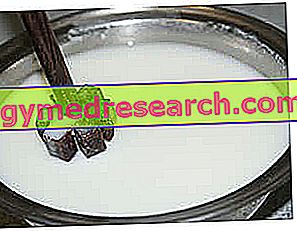Generality
Buttermilk is a derivative of milk obtained as processing waste during the production of butter. Because it contains significant amounts of lactose (3-5g / 100 ml), buttermilk is considered a dairy product .

Buttermilk is presented as a clear liquid, more transparent and acid than milk, much more similar to the SERUM obtained from the production of cheese. In fact, this similarity is due to a manufacturing process that, although quite different, has the same chemical-physical objective.
Buttermilk is NOT a product typically consumed in Italy. On the contrary, it seems very common in the Anglo-Saxon countries (with the name of buttermilk), in the Scandinavian countries, in some Eastern European nations and in certain areas of the Middle East. It should then be specified that under the name "buttermilk" or "buttermilk" a whole series of drinks is grouped which, to tell the truth, DO NOT have the same characteristics or the same processing as the "traditional" one. Generally speaking, all clear drinks obtained from (or with) acidified milk or cream are defined as "buttermilk". Below we will understand WHY this definition is to be considered totally approximate.
Production
As anticipated, buttermilk is a waste product, albeit edible, of butter production.
During the production of the butter the MECHANICAL separation of some CASEINE proteins and the FATS contained in the MILK CREAM takes place. The latter, which is the fat part of the food, can be obtained by spontaneous surfacing or centrifugation. In the first case the milk is left to rest for several hours, during which the lactic bacteria acidify the product; in the second, however, the cream is obtained quickly through a mechanical centrifugation process. Since the activity of lactic bacteria is important for the final aroma of the butter, the cream obtained by centrifugation is grafted with selected microbial strains and left to mature for a few hours. Instead, that obtained by surfacing is already fermented, although this process, not being standardized, can also give unpleasant aromas to the product and make it less storable. For this reason, the butter obtained from centrifuged cream is now considered better than that obtained from the emergence of the cream.
Once the cream has been obtained, the separation of fats and proteins from the buttermilk occurs by mechanical stress (shaking) of the product which, consequently, develops a real protein network stabilized by fat (present in abundance). The result is the formation of rather compact granules (of fat and protein) well separated from the residual serous liquid; the first, washed and pressed, will give rise to butter, the second is precisely unripe buttermilk.
Obviously, the lowering of the pH following the acidification of the milk cream is NOT without consequences on the protein portion of the buttermilk; a part of it, due to the presence of lactic acid, coagulates and precipitates in the buttermilk serum. In fact, with the butter making process, ONLY the casein proteins necessary to make up a network saturated with fats are separated, while the others remain dispersed and will form the final buttermilk.
Now, if the traditional buttermilk can be defined as ready, that obtained from INTEGRA (not acid) milk cream, for example by centrifugation of the cream, is instead still "unripe"; only after the inoculation of certain bacteria ( Lactococcus lactis and / or Lactobacillus bulgaricus ) that ferment lactose with lactic acid production, the drink acquires the right level of acidity. This type of buttermilk is also called "artificial" buttermilk.
Precisely on the basis of the nature of these last two passages it is possible to distinguish two types of buttermilk: the traditional one, more granular than milk but still liquid, and the inoculated one, less grainy, more viscous and more acid than the previous one (therefore more similar to yogurt) .
At this point it is certainly much clearer what the difference between buttermilk and whey production can be. While the first is obtained by churning the butter, obtained mechanically, the second represents the waste of the curd, obtained by acidification with rennet and / or fermentation and / or by thermal coagulation, therefore exempt from the mechanical process. To put it in simple words, buttermilk represents the waste of butter while the serum represents the cheese waste.
Buttermilk Production
The buttering system just described, applied automatically in the food industry, can be easily reproduced at home → look at the video-butter "Homemade butter"
The buttermilk can in fact be produced by subjecting the fresh or inoculated (refrigerated) cream to mechanical agitation with an electric whisk, for about 15/20 minutes. This way you will get butter on one side and buttermilk on the other. The latter is kept for about 2-3 days in the refrigerator.
There is also a "fake" version of the buttermilk obtained by mixing skimmed milk, low-fat yogurt and an acid base (isolated acids or lemon juice or vinegar). There is also a commercial version better known as "acidified buttermilk".
Homemade Buttermilk
X Problems with video playback? Reload from YouTube Go to Video Page Go to Video Recipes Section Watch the video on youtubeCURIOSITY
Buttermilk is an essential and irreplaceable ingredient for the traditional Irish recipe of Soda Bread, or leavened bread with chemical yeast. This baked product exploits the release of carbon dioxide by interaction between sodium bicarbonate (another essential ingredient) and the lactic acid of buttermilk.
In the territory of Southern India and in the neighboring areas, buttermilk with added water, sugar and / or salt, asafoetida and curry is an everyday food in food.
In American cuisine, buttermilk is used in the production of pancakes and for marinating fried chicken.
Property
Buttermilk is considered a PROBIOTIC food, therefore it is beneficial for the health of the large intestine; however, it is not clear how many bacteria are capable of actually exceeding the acid barrier of the stomach.
It is said that buttermilk can be beneficial for the skin and for the gastric mucosa, but its main characteristic is the LOW percentage of fat compared to whole milk, to its curd and to the whey that remains.
Furthermore, buttermilk has an excellent content in mineral salts (calcium, potassium and phosphorus).
The buttermilk brings about 40kcal per 100g of liquid, supplied mostly from lactose (3-5g / 100g), then from proteins (just over 3g / 100g) and finally from fats (mainly saturated, less than 0.9g / 100g ). Calcium reaches and can exceed 100mg / 100g.
Ultimately, the nutritional composition of buttermilk is very similar to that of low-fat milk, with 91-92% water, 3-3.4% protein, 0.1-0.5% fat, 0.7% salts, lactose and lactic acid in different proportions depending on whether the acidification (of the milk cream or the buttermilk itself) has already taken place or not (and in what quantity).
We remind you that buttermilk is not indicated in the diet of lactose intolerant subjects.



